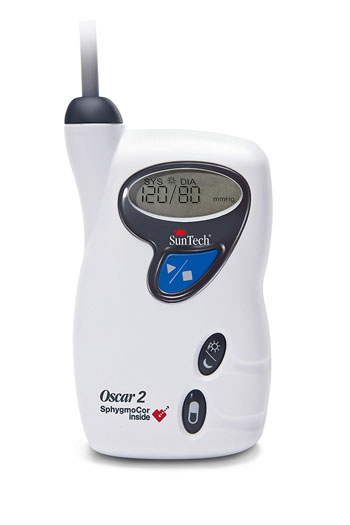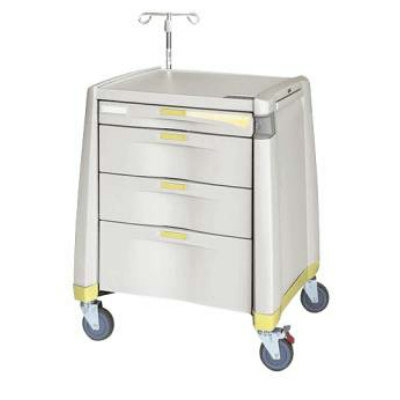User-Centered BP Monitor Provides Accurate 24-Hour Readings
|
By HospiMedica International staff writers Posted on 30 Mar 2016 |
A novel ambulatory blood pressure monitor (ABPM) provides noninvasive measures of central arterial blood pressure waveforms, central aortic blood pressures, and arterial stiffness indices.
The Oscar 2 with SphygmoCor Inside technology is a light, compact monitor that uses motion tolerant algorithms and auto-intelligent inflation to reduce re-inflates and failed readings. The paired Orbit BP cuff, which uses an innovative stretch-sleeve design to maintain cuff placement and promote patient comfort, allows for noninvasive assessment of the central arterial pressure waveform and arterial stiffness, with a transfer function.
The predictive superiority of central arterial pressure waveform analysis using SphygmoCor Inside technology over standard brachial blood pressure is primarily due to the closer proximity of the ascending aorta to important target organs such as the heart, brain, and kidney. The Oscar 2 also includes motion-tolerant technology to help eliminate ambulation and noise artifacts that can cause failed readings and the need for repeated studies. In addition, sub-diastolic waveform measurement delivers a fully-featured physiological waveform with accurate augmentation index.
The ABPM monitor is also designed to be used with proprietary AccuWin Pro 4 software that allows data to be directly exported to a computer database for efficient programming, measurement analysis, and physician interpretation and report. The Oscar 2 was developed as part of a multi-year alliance between SunTech Medical (Morrisville, NC, USA) and AtCor Medical (West Ryde, Australia), and has received the European Community CE marking of approval.
Central arterial blood pressure is the pressure in the aorta, thus representing the pressure that the heart has to pump against to get blood to flow to the rest of the body, including the blood vessels feeding the brain. It has been shown to more strongly relate to vascular disease and outcome—such as stroke and aneurysm—than traditional upper arm (brachial) blood pressure. It also can distinguish between the effects of different hypertension medications when upper arm blood pressure and pulse wave velocity do not.
Related Links:
SunTech Medical
AtCor Medical
The Oscar 2 with SphygmoCor Inside technology is a light, compact monitor that uses motion tolerant algorithms and auto-intelligent inflation to reduce re-inflates and failed readings. The paired Orbit BP cuff, which uses an innovative stretch-sleeve design to maintain cuff placement and promote patient comfort, allows for noninvasive assessment of the central arterial pressure waveform and arterial stiffness, with a transfer function.
The predictive superiority of central arterial pressure waveform analysis using SphygmoCor Inside technology over standard brachial blood pressure is primarily due to the closer proximity of the ascending aorta to important target organs such as the heart, brain, and kidney. The Oscar 2 also includes motion-tolerant technology to help eliminate ambulation and noise artifacts that can cause failed readings and the need for repeated studies. In addition, sub-diastolic waveform measurement delivers a fully-featured physiological waveform with accurate augmentation index.
The ABPM monitor is also designed to be used with proprietary AccuWin Pro 4 software that allows data to be directly exported to a computer database for efficient programming, measurement analysis, and physician interpretation and report. The Oscar 2 was developed as part of a multi-year alliance between SunTech Medical (Morrisville, NC, USA) and AtCor Medical (West Ryde, Australia), and has received the European Community CE marking of approval.
Central arterial blood pressure is the pressure in the aorta, thus representing the pressure that the heart has to pump against to get blood to flow to the rest of the body, including the blood vessels feeding the brain. It has been shown to more strongly relate to vascular disease and outcome—such as stroke and aneurysm—than traditional upper arm (brachial) blood pressure. It also can distinguish between the effects of different hypertension medications when upper arm blood pressure and pulse wave velocity do not.
Related Links:
SunTech Medical
AtCor Medical
Read the full article by registering today, it's FREE! 

Register now for FREE to HospiMedica.com and get access to news and events that shape the world of Hospital Medicine. 
- Free digital version edition of HospiMedica International sent by email on regular basis
- Free print version of HospiMedica International magazine (available only outside USA and Canada).
- Free and unlimited access to back issues of HospiMedica International in digital format
- Free HospiMedica International Newsletter sent every week containing the latest news
- Free breaking news sent via email
- Free access to Events Calendar
- Free access to LinkXpress new product services
- REGISTRATION IS FREE AND EASY!
Sign in: Registered website members
Sign in: Registered magazine subscribers
Latest Critical Care News
- Glowing Bacteria ‘Pills’ for Detecting Gut Diseases Could Eliminate Colonoscopies
- Skin-Permeable Polymer Patch Delivers Insulin Non-Invasively Through Skin
- Nanogel Technology Almost 100% Effective in Destroying Drug-Resistant Bacteria Within Hours
- Wearable Ultrasound Sensor Delivers Noninvasive Treatment Without Surgery
- Gel-Free ECG System to Transform Heart Health Diagnosis
- Biodegradable Patch Repairs Damaged Tissue After Heart Attack
- Magnetically Guided Microrobots to Enable Targeted Drug Delivery

- Smart Nanomaterials Detect and Treat Traumatic Brain Injuries Simultaneously
- Earlier Blood Transfusion Could Reduce Heart Failure and Arrhythmia in Heart Disease Patients
- 'Smart' Shirt Detects Epileptic Seizures in Real Time
- Skin Patch Measures Effectiveness of Flu/COVID Vaccines in 10 Minutes
- Complete Revascularization Reduces Risk of Death from Cardiovascular Causes
- Tiny Fish-Inspired Robots Navigate Through Body to Deliver Targeted Drug Therapy
- Coronary Artery Stenosis Could Protect Patients from Pulmonary Embolism Effects
- Sweat-Powered Sticker Turns Drinking Cup into Health Sensor
- Skin-Mounted 3D Microfluidic Device Analyzes Sweat for Real-Time Health Assessment
Channels
Surgical Techniques
view channelNovel Endoscopy Technique Provides Access to Deep Lung Tumors
Detecting lung cancer early can save lives, but diagnosing small tumors deep in the outer regions of the lungs remains a major clinical challenge. Although CT scans frequently identify tiny suspicious... Read more
New Study Findings Could Halve Number of Stent Procedures
When a coronary artery becomes acutely blocked during a heart attack, opening it immediately is essential to prevent irreversible damage. However, many patients also have other narrowed vessels that appear... Read morePatient Care
view channel
Revolutionary Automatic IV-Line Flushing Device to Enhance Infusion Care
More than 80% of in-hospital patients receive intravenous (IV) therapy. Every dose of IV medicine delivered in a small volume (<250 mL) infusion bag should be followed by subsequent flushing to ensure... Read more
VR Training Tool Combats Contamination of Portable Medical Equipment
Healthcare-associated infections (HAIs) impact one in every 31 patients, cause nearly 100,000 deaths each year, and cost USD 28.4 billion in direct medical expenses. Notably, up to 75% of these infections... Read more
Portable Biosensor Platform to Reduce Hospital-Acquired Infections
Approximately 4 million patients in the European Union acquire healthcare-associated infections (HAIs) or nosocomial infections each year, with around 37,000 deaths directly resulting from these infections,... Read moreFirst-Of-Its-Kind Portable Germicidal Light Technology Disinfects High-Touch Clinical Surfaces in Seconds
Reducing healthcare-acquired infections (HAIs) remains a pressing issue within global healthcare systems. In the United States alone, 1.7 million patients contract HAIs annually, leading to approximately... Read moreHealth IT
view channel
EMR-Based Tool Predicts Graft Failure After Kidney Transplant
Kidney transplantation offers patients with end-stage kidney disease longer survival and better quality of life than dialysis, yet graft failure remains a major challenge. Although a successful transplant... Read more
Printable Molecule-Selective Nanoparticles Enable Mass Production of Wearable Biosensors
The future of medicine is likely to focus on the personalization of healthcare—understanding exactly what an individual requires and delivering the appropriate combination of nutrients, metabolites, and... Read moreBusiness
view channel
Philips and Masimo Partner to Advance Patient Monitoring Measurement Technologies
Royal Philips (Amsterdam, Netherlands) and Masimo (Irvine, California, USA) have renewed their multi-year strategic collaboration, combining Philips’ expertise in patient monitoring with Masimo’s noninvasive... Read more
B. Braun Acquires Digital Microsurgery Company True Digital Surgery
The high-end microsurgery market in neurosurgery, spine, and ENT is undergoing a significant transformation. Traditional analog microscopes are giving way to digital exoscopes, which provide improved visualization,... Read more
CMEF 2025 to Promote Holistic and High-Quality Development of Medical and Health Industry
The 92nd China International Medical Equipment Fair (CMEF 2025) Autumn Exhibition is scheduled to be held from September 26 to 29 at the China Import and Export Fair Complex (Canton Fair Complex) in Guangzhou.... Read more

















